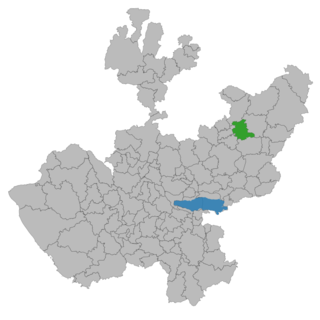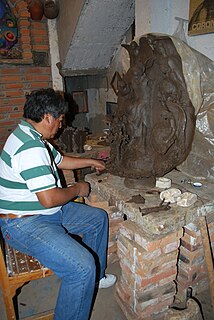The Aguirre family is a Mexican artisan family specializing in inlaid wood items. Two of the family members, Silvano and Francisco, have been named "grand masters" of Mexican folk art by the Fomento Cultural Banamex . [1]

Marquetry is the art and craft of applying pieces of veneer to a structure to form decorative patterns, designs or pictures. The technique may be applied to case furniture or even seat furniture, to decorative small objects with smooth, veneerable surfaces or to freestanding pictorial panels appreciated in their own right.
The family is from Jalostotitlán, Jalisco in western Mexico, a town known for its inlaid wood products. The technique was brought to Mexico from Europe and has since then taken on Mexican elements especially in design. [1]

Jalostotitlán is a town and municipality located in the northeast corner of the state of Jalisco, Mexico, in a region known as Los Altos.

Jalisco, officially the Free and Sovereign State of Jalisco, is one of the 31 states which, with the Federal District, comprise the 32 Federal Entities of Mexico. It is located in Western Mexico and is bordered by six states which are Nayarit, Zacatecas, Aguascalientes, Guanajuato, Michoacán and Colima. Jalisco is divided into 125 municipalities, and its capital city is Guadalajara. Jalisco is one of the most important states in Mexico because of its natural resources as well as its history. Many of the characteristic traits of Mexican culture, particularly outside Mexico City, are originally from Jalisco, such as mariachi, ranchera music, birria, tequila, jaripeo, etc., hence the state's motto: "Jalisco es México." Economically, it is ranked third in the country, with industries centered in the Guadalajara metropolitan area, the second largest metropolitan area in Mexico. The state is home to two significant indigenous populations, the Huichols and the Nahuas. There is also a significant foreign population, mostly retirees from the United States and Canada, living in the Lake Chapala and Puerto Vallarta areas.
Francisco Aguirre has dedicated his life to preserving the craft and reviving it, teaching his sons Silvano and Francisco. The elder learned the craft and a number of original designs from his own father. The family specializes in smaller objects such as storage boxes, mirror frames and animal figures made from mahogany and cypress using other woods such as orange and copal for the inlaid designs. These smaller, delicate pieces of wood are cut using a standard sewing machine. The smallest pieces require tweezers to lay them exactly right. They generally make pieces to order. [1]

Mahogany is a kind of wood—the straight-grained, reddish-brown timber of three tropical hardwood species of the genus Swietenia, indigenous to the Americas and part of the pantropical chinaberry family, Meliaceae.
The family has earned a number of awards and other recognitions from organizations such as the Instituto Nacional de Bellas Artes y Literatura, the Casa de Artesanías de Jalisco and the Premio Fomento Cultural Banamex. The elder won major awards at the Feria de las Artesanías in Jalisco in 1969 and the Concurso Municipal de Artesanía in 1994. [1]

The Instituto Nacional de Bellas Artes y Literatura, located in the Palacio de Bellas Artes in Mexico City, is the Mexican institution in charge of coordinating artistic and cultural activities in the country.







